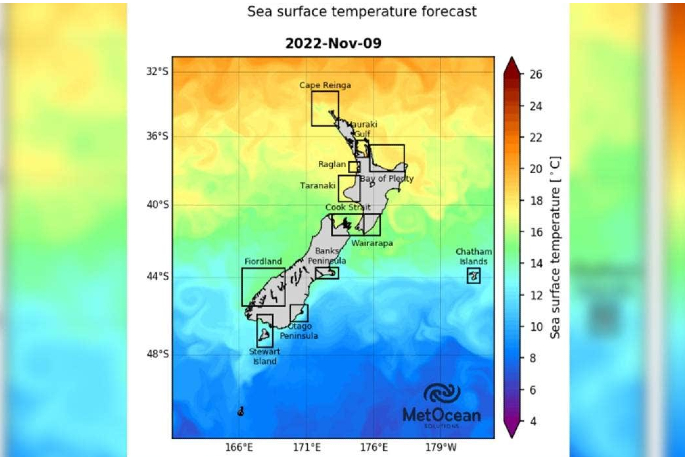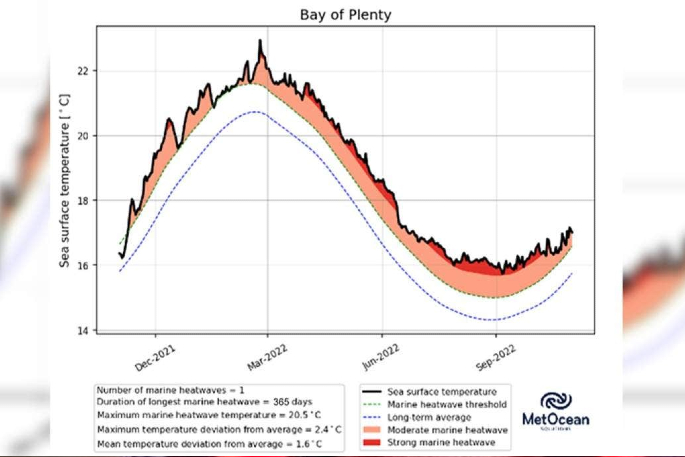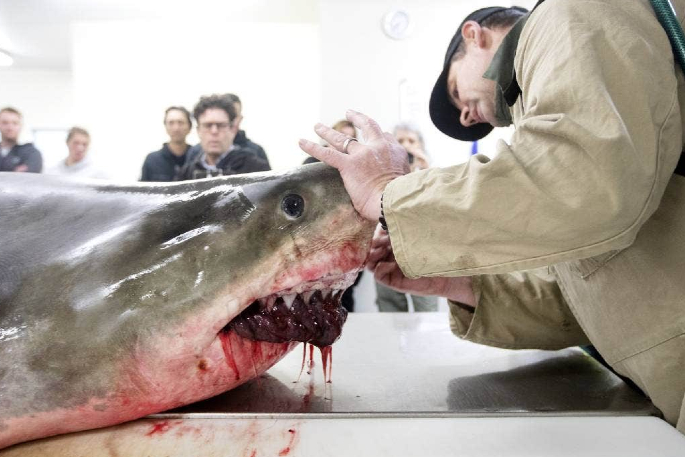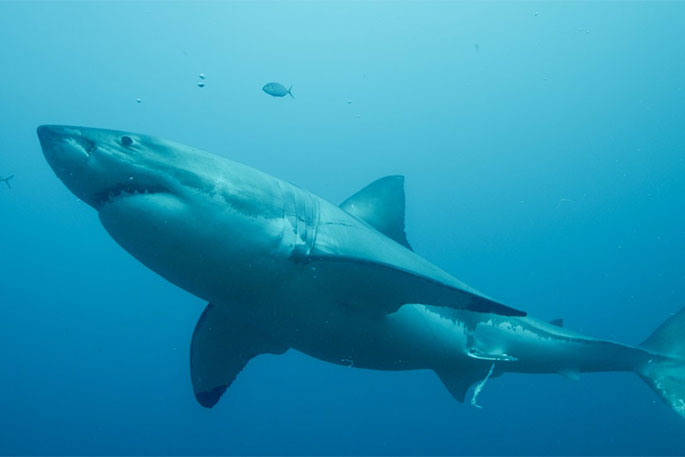Beach goers will enjoy warmer water in holiday hotspots like Mount Maunganui and Raglan this summer – but it's not all good, as marine heatwaves adversely affect marine life, increase rain and tropical cyclones, and may lure sharks.
Marine heatwave conditions in the Bay of Plenty have now lasted an unprecedented full year – the longest continuous marine heatwave so far recorded for New Zealand.
The warming is part of a record year of upper North Island marine heatwaves, according to Moana Project oceanographer Dr Robert Smith.

Sea surface temperatures around New Zealand are consistently high, with several areas under prolonged marine heatwave conditions. Photo: Supplied/Stuff.
The current marine heatwave in the Bay of Plenty started on November 9, 2021 explains Dr Smith from the University of Otago.
'Over the last year, sea surface temperatures have remained on average 1.6°C degrees warmer than the long-term average. Pronounced marine heatwave conditions continued during the winter; the Bay of Plenty never really experienced normal winter ocean temperatures. Instead, water temperatures reached 2.4°C above normal.”
Swimmers and surfers will notice that they can stay in the water for longer, says Smith.
'This warming is unprecedented over at least the past 40 years and is not only affecting the surface. Moana Project temperature observations collected in collaboration with commercial fishers show that noticeable warming has extended to depths of at least 60 metres.”
When a similar marine heatwave began off the west coast of the USA in 2013, juvenile white sharks were seen 'for the first time in recorded history” in Monterey Bay, California says Kyle Van Houtan, former chief scientist at the Monterey Bay Aquarium.

Moana Project oceanographer Dr Robert Smith. Photo: Supplied/Stuff.
That heatwave, known as ‘The Blob' which lasted three years, then returned, also had a devastating impact on the region's fishing industry and was thought to be a reason why a surge of dead whales washed up along the coast.
Other areas in the North Island have broken local records too. Waters off Cape Reinga / Te Rerenga Wairua experienced marine heatwave conditions for more than 95% of the time in the last year, and off Raglan and Taranaki marine heatwaves persisted more than 80% of the time. In the Hauraki Gulf, 274 days had marine heatwave conditions, which is 75% of the year, says Smith.

The Bay of Plenty has been under marine heatwave conditions for a year. Photo: Supplied.
Technical marine adviser at the Department of Conservation, shark expert Clinton Duffy, says how warmer waters might affect the movements and distribution of shark species in New Zealand waters is uncertain.
Duffy is part of a team of top shark experts lead by University of Waikato marine biologist Phil Ross and local iwi which have launching a project to investigate an increase in great white sharks in Bay of Plenty waters.
”Currently few predictions of how their habitat might change under different climate change scenarios have been made, and importantly few of the existing models include biological interactions such as potential shifts in prey distribution. This is partly because we know very little about the biology of most of our shark species, and partly because most models have been developed to assess overlap with fisheries and not climate change effects,” he says.
Jason Down was fishing for snapper at Waikawau beach, about 100 kilometres north of New Plymouth, when a bigger set of jaws appeared. (Video first published May 2022). Video: Supplied/Stuff.
Calls to monitor growing shark numbers increased last summer after members of the region's surfing and fishing communities became increasingly fearful for their safety on the water.
Duffy says shark sightings usually peak over spring and summer as more people head to the beach and several coastal shark species move inshore to pup and feed on abundant inshore fish. During this period, calm conditions and cleaner water makes for easier swimming conditions for sharks closer to shore.

DOC marine scientist Clinton Duffy studying and measuring a great white shark. Photo: Andy Jackson/Stuff.
The most common species seen every summer around coasts, such as bronze whalers, hammerheads, great white sharks, mako, blue and thresher sharks, reside in New Zealand waters for all or a substantial part of each year.
'Tracking studies have shown that individuals of those species that leave New Zealand generally return here, often to places they appear to favour. Female sharks generally return to the place they were born to give birth.”
Waihī Beach in the western Bay of Plenty was the scene of the last fatal shark attack in New Zealand in January 2021, when Hamilton woman Kaelah Marlow died after being mauled in the ocean by a great white shark.
Since the attack at Waihī Beach there have been a number of great white shark sightings over the past year, with videos posted online of sharks circling fishing boats and chasing fish.
Earlier this year Mount surfer Vaughan Wilson had a near miss with a '3.5 metre monster” just off Matakana Island.
On November 5, a local fishing charter boat in Whitianga gained an extra guest when a huge shark leapt on board.
Locals such as Peter Rogers have plenty of great white shark stories to tell, yet swimmers are still doing their thing at Bowentown. Video: Christel Yardley/Stuff.
The long-running marine heatwave conditions are likely caused by a combination of factors. This includes recent changes in ocean currents that transport heat around northern New Zealand, persistent La Niña conditions in the Pacific Ocean, and broad-scale warming of the upper-ocean around New Zealand driven by climate change.
Recent marine heatwaves around New Zealand have caused die-offs of some marine species, including coastal kelp forests and penguins. They have led to shifts in the distribution of fish stocks, with warmer water species turning up in unexpected places. They have also led to wide-spread bleaching of native sea sponges across New Zealand, which form important habitat along our coastlines, says Smith.
'If, as we expect) the current marine heatwave conditions extend throughout summer, these sorts of impacts are likely to become evident around parts of upper north island of New Zealand.”
Ocean temperatures affect not only marine life, but also the general weather we see on land.
MetService head of weather communications, Lisa Williams says that marine heatwaves can exacerbate rain events.
'A warmer sea heats the air travelling over it and because warmer air can mean more moisture, we can get more rain.”
Warmer ocean conditions can also favour the earlier development, and stronger growth, of tropical cyclones says Smith.
- Annemarie Quill/Stuff.co.nz.



2 comments
Increased rain?
Posted on 15-11-2022 07:35 | By jed
This has been the wettest year since I have lived in Mt Maunganui. I trust there will be no council water restrictions this summer then.
Why?
Posted on 15-11-2022 13:56 | By morepork
Obviously, we are seeing more sharks. They wouldn't be anywhere near boats or humans under "normal" circumstances, so things must be getting tough for them. Considering the tonnes of fish we take regularly it is hardly surprising. Warmer waters are just a part of it; increased removal of fish stocks by humans must also play a part. In an ideal world we would let them have the fish (we can certainly eat other things....) but the world is not ideal and humans need fish too. So, it may come down to having to cull the shark population or otherwise control it, even if we don't want to do this.
Leave a Comment
You must be logged in to make a comment.